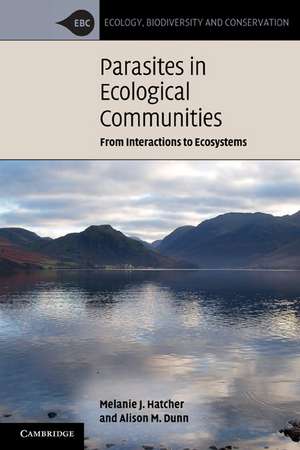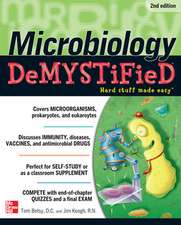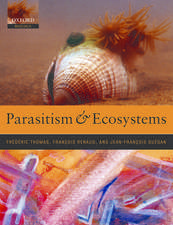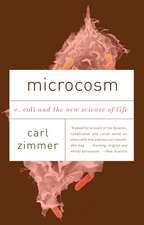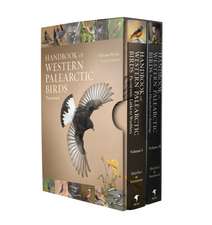Parasites in Ecological Communities: From Interactions to Ecosystems: Ecology, Biodiversity and Conservation
Autor Melanie J. Hatcher, Alison M. Dunnen Limba Engleză Paperback – 15 iun 2011
| Toate formatele și edițiile | Preț | Express |
|---|---|---|
| Paperback (1) | 451.52 lei 3-5 săpt. | |
| Cambridge University Press – 15 iun 2011 | 451.52 lei 3-5 săpt. | |
| Hardback (1) | 707.07 lei 6-8 săpt. | |
| Cambridge University Press – 15 iun 2011 | 707.07 lei 6-8 săpt. |
Din seria Ecology, Biodiversity and Conservation
-
 Preț: 349.59 lei
Preț: 349.59 lei -
 Preț: 276.13 lei
Preț: 276.13 lei -
 Preț: 230.82 lei
Preț: 230.82 lei -
 Preț: 307.23 lei
Preț: 307.23 lei -
 Preț: 356.75 lei
Preț: 356.75 lei -
 Preț: 274.22 lei
Preț: 274.22 lei -
 Preț: 303.89 lei
Preț: 303.89 lei -
 Preț: 351.53 lei
Preț: 351.53 lei -
 Preț: 305.80 lei
Preț: 305.80 lei -
 Preț: 320.13 lei
Preț: 320.13 lei -
 Preț: 355.36 lei
Preț: 355.36 lei -
 Preț: 278.29 lei
Preț: 278.29 lei -
 Preț: 353.48 lei
Preț: 353.48 lei -
 Preț: 328.88 lei
Preț: 328.88 lei -
 Preț: 311.14 lei
Preț: 311.14 lei -
 Preț: 387.22 lei
Preț: 387.22 lei - 8%
 Preț: 530.70 lei
Preț: 530.70 lei -
 Preț: 314.82 lei
Preț: 314.82 lei -
 Preț: 306.08 lei
Preț: 306.08 lei -
 Preț: 471.17 lei
Preț: 471.17 lei -
 Preț: 466.38 lei
Preț: 466.38 lei -
 Preț: 402.68 lei
Preț: 402.68 lei - 14%
 Preț: 981.14 lei
Preț: 981.14 lei -
 Preț: 454.76 lei
Preț: 454.76 lei - 11%
 Preț: 565.77 lei
Preț: 565.77 lei - 14%
 Preț: 709.39 lei
Preț: 709.39 lei -
 Preț: 441.83 lei
Preț: 441.83 lei - 14%
 Preț: 929.04 lei
Preț: 929.04 lei - 11%
 Preț: 477.70 lei
Preț: 477.70 lei - 14%
 Preț: 701.48 lei
Preț: 701.48 lei - 14%
 Preț: 1013.18 lei
Preț: 1013.18 lei
Preț: 451.52 lei
Preț vechi: 507.33 lei
-11% Nou
86.40€ • 90.45$ • 71.49£
Carte disponibilă
Livrare economică 15-29 martie
Specificații
ISBN-10: 0521718228
Pagini: 464
Ilustrații: 113 b/w illus. 7 tables
Dimensiuni: 154 x 228 x 21 mm
Greutate: 0.75 kg
Editura: Cambridge University Press
Colecția Cambridge University Press
Seria Ecology, Biodiversity and Conservation
Locul publicării:Cambridge, United Kingdom
Cuprins
Part I. Introduction; Part II. Parasites and Competitors: 1. Introduction; 2. One host-one parasite systems; 3. Apparent competition; 4. Parasite-mediated competition; 5. Parasite-modified competition; 6. Examples from conservation and management; 7. Competition between parasites; 8. Conclusions; Part III. Parasites and Predators: 9. Introduction; 10. Parasites of prey with specialist predators; 11. Parasites of prey with generalist predators; 12. Parasites of predator; 13. Parasites of predator and prey; 14. Applications: predator control and harvesting; 15. Conclusions; Part IV. Parasites and Intraguild Predation: 16. Introduction; 17. Ecological significance of IGP; 18. IGP as a unifying framework for competition and predation; 19. Parasites intrinsic to IGP; 20. Parasites extrinsic to IGP; 21. Models of parasitism extrinsic to IGP; 22. IGP and the evolution of host-parasite relationships; 23. Conclusions; Part V. Plant Pathogens and Parasitic Plants: 24. Introduction: parasitism of plants; 25. Soil borne pathogens; 26. Plant defence strategies; 27. Parasitic plants; 28. Endophytes; 29. Conclusions; Part VI. Parasites and Invasions: 30. Introduction; 31. Parasite introduction and acquisition; 32. Loss of parasites by invaders: enemy release; 33. Invasions and host-parasite co-evolution; 34. The impact of parasitism on biological invasion; 35. Conclusions; Part VII. Ecosystem Parasitology: 36. Introduction; 37. Trophic cascades; 38. Parasite dynamics in multihost communities; 39. Biodiversity and disease; 40. Parasites in the food web; 41. Bioenergetic implications of parasitism; 42. Ecosystem engineering; 43. Ecosystem health; 44. Evolutionary considerations; 45. Conclusions; Part VIII. Emerging Diseases in Humans and Wildlife: 46. Introduction; 47. The process of disease emergence; 48. The evolution of emergence; 49. Phylogenetic and temporal patterns of emergence; 50. Environmental change and emergence; 51. Conservation and control; 52. Conclusions; Part IX. Where Do We Go From Here?; References; Index.
Recenzii
'The ecology of infectious disease is a fast growing topic … To date, there has not been an adequate text to teach from. [This book] … fills this niche well. In contrast to contributed volumes, [it] speaks with a single voice. The authors use themes centered around mathematical epidemiology and community ecology, but they do so in such a way that is accessible to non-math savvy students … does a very good job summarizing the relevant literature in tables that efficiently indicate who has done what on a particular question. The text covers many systems … We just finished using it in our graduate seminar and found it to be up to date and comprehensive. Since then, I have referred to it regularly … will be required reading for our future graduate students … should be required reading for any ecologist.' Kevin Lafferty, US Geological Survey
Descriere
Interactions between competitors, predators and their prey have traditionally been viewed as the foundation of community structure. Parasites – long ignored in community ecology – are now recognized as playing an important part in influencing species interactions and consequently affecting ecosystem function. Parasitism can interact with other ecological drivers, resulting in both detrimental and beneficial effects on biodiversity and ecosystem health. Species interactions involving parasites are also key to understanding many biological invasions and emerging infectious diseases. This book bridges the gap between community ecology and epidemiology to create a wide-ranging examination of how parasites and pathogens affect all aspects of ecological communities, enabling the new generation of ecologists to include parasites as a key consideration in their studies. This comprehensive guide to a newly emerging field is of relevance to academics, practitioners and graduates in biodiversity, conservation and population management, and animal and human health.
